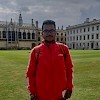Physics major Oem Trivedi is pursuing his BS (Hons) at the School of Arts and Sciences. Deeply passionate about quantum gravity and cosmological singularities, the undergraduate experience at Ahmedabad University has offered Oem a platform to develop his research in the domain. Here, he writes about his studies, some of them in collaboration with Professor Maxim Khlopov from CNRS Paris.
The universe is an immense and mysterious place filled with countless stars, planets, and galaxies, a place of unparalleled beauty. The laws of physics and the forces of nature combine to create a symphony of wonder, from the spiral arms of distant galaxies to the dance of cosmic dust. It is a never-ending source of inspiration and awe. The universe is a place of stunning beauty, yet it also poses many profound questions about the laws that govern it. Despite our progress in space exploration, we still have much to learn about the universe, from its origins to the fundamental building blocks that make it up.
For the past three years, my research has been focused on understanding the insights that quantum gravity can provide into the workings of the universe. Quantum gravity is a field of physics that aims to reconcile quantum mechanics and general relativity at the smallest scales. The most beautiful aspect of quantum gravity is how it connects the infinitesimally small with the infinitely large. The String Theory, for instance, posits that the universe’s building blocks are tiny, one-dimensional ‘strings’ that vibrate at different frequencies rather than point-like particles. The swampland conjectures from string theory, although unproven till now, can aid in understanding quantum gravity by providing criteria for consistency and viability. These criteria limit potential theories and provide a more precise direction for future research. My initial research in cosmology focused on understanding the implications of these criteria for the early universe. It yielded several insights, such as the possibility of theories other than Einstein’s general relativity being favoured in the early universe and the possibility of multiple universes.
The birth of the universe is a fascinating topic, but it’s not the only thing worth studying. My recent work has been focused on understanding the current epoch of the universe and the role of dark energy in it. Dark energy is a mysterious form of energy driving the universe’s recent accelerated expansion and is one of modern physics’ biggest mysteries. While it is widely believed that the cosmological constant, a term in Einstein’s theory of general relativity that represents the energy density of the vacuum of space, is the source of dark energy, other alternatives have been proposed. These alternatives include modifications of general relativity and the use of certain quantum fields like the Quintessence field. This research has been catalysed by the Hubble tension, which is a discrepancy between the observed and predicted values of the expansion rate of the universe. This discrepancy is a new puzzle that needs to be understood. The advent of research on dark energy gave birth to another interesting paradigm, that of cosmological singularities.
One usually thinks about black holes when we talk about singularities in space-time. A black hole singularity is a point of infinite density and infinite gravity. It is also known as the ‘centre’ of a black hole. The existence of singularities in black holes was first proposed in the early 20th century, but they are not the only astrophysical singularities out there. On the other hand, cosmological singularities do not lie at the centre of black holes and are more dynamic in nature than black hole singularities. They have a diverse classification, too, some of them just impact small patches of the universe, and some of them can even end the universe or create a new one!
In the past year, I have published six papers, three of which I co-wrote with Professor Maxim Khlopov from CNRS Paris. These papers examined the potential outcomes for dark energy that stem from quantum gravity theories. My findings indicate that quantum gravity has the potential to cause various cosmological singularities in the universe and could even prevent some of these singularities. My work has also talked about connections between the Hubble tension and the uncertainty principle, one of the most fundamental ideas of quantum mechanics. Doing research as an undergraduate has helped me tremendously as it has increased my understanding of research and academia multifold. Ahmedabad University has a research-friendly environment, and that has encouraged me to pursue my goals. In particular, discussions with Professor Raghavan Rangarajan and Professor Pankaj Joshi have extensively guided me.


